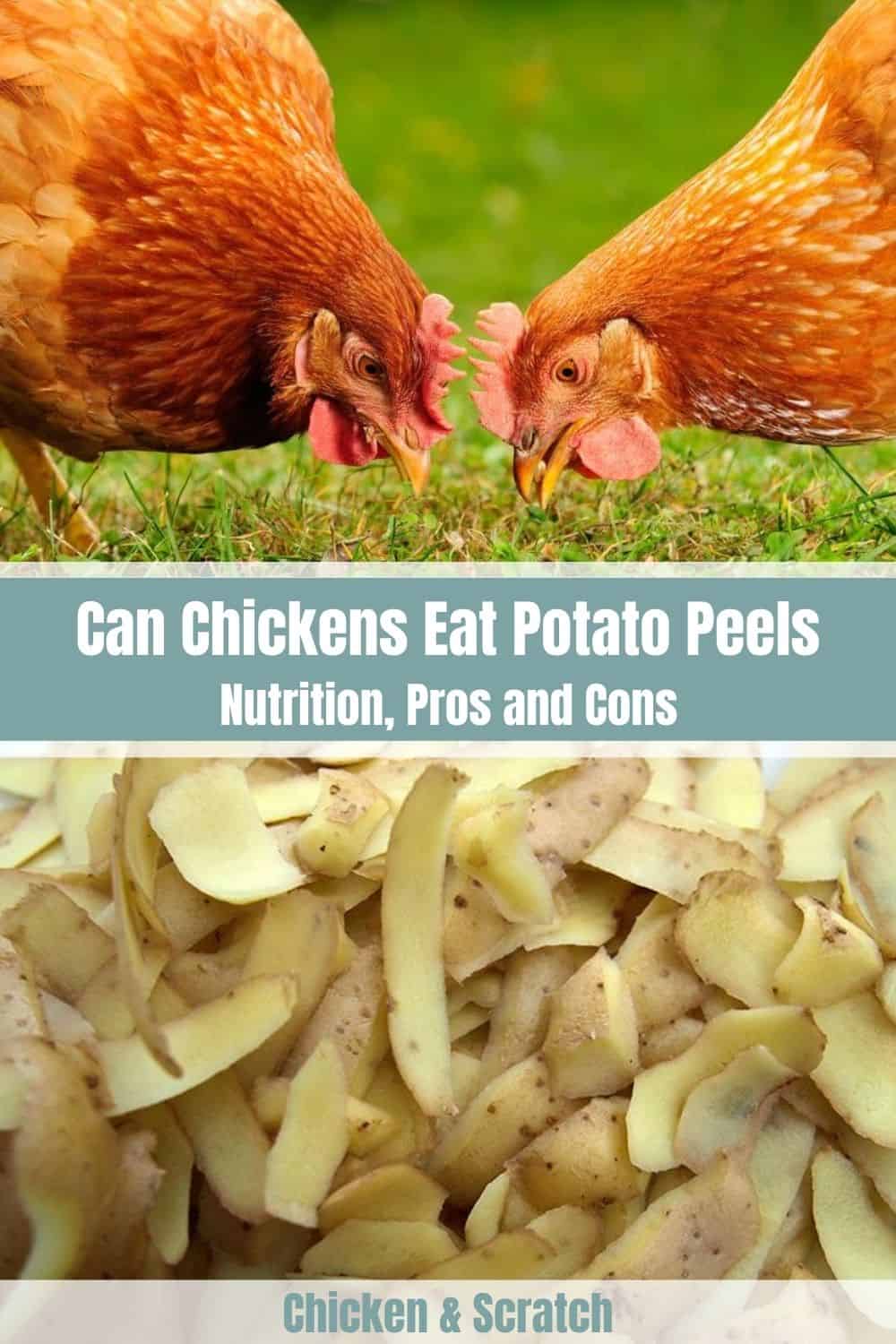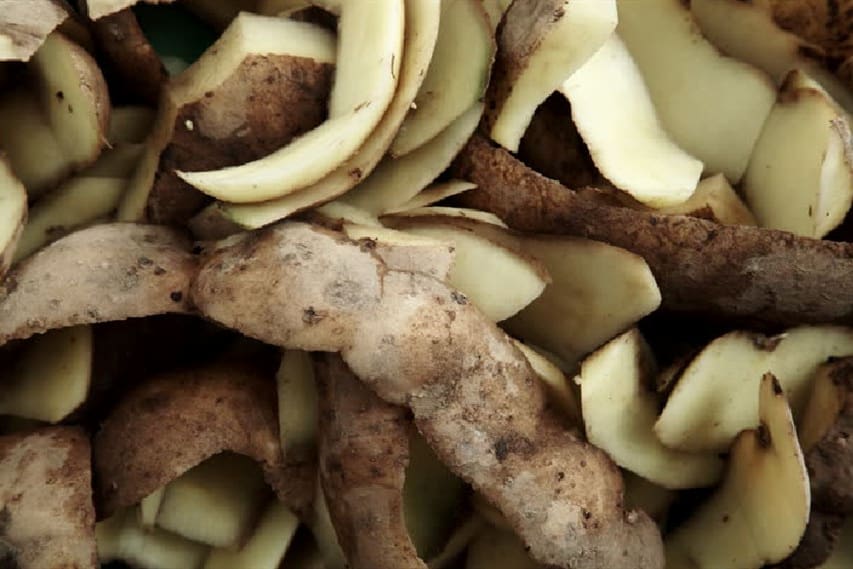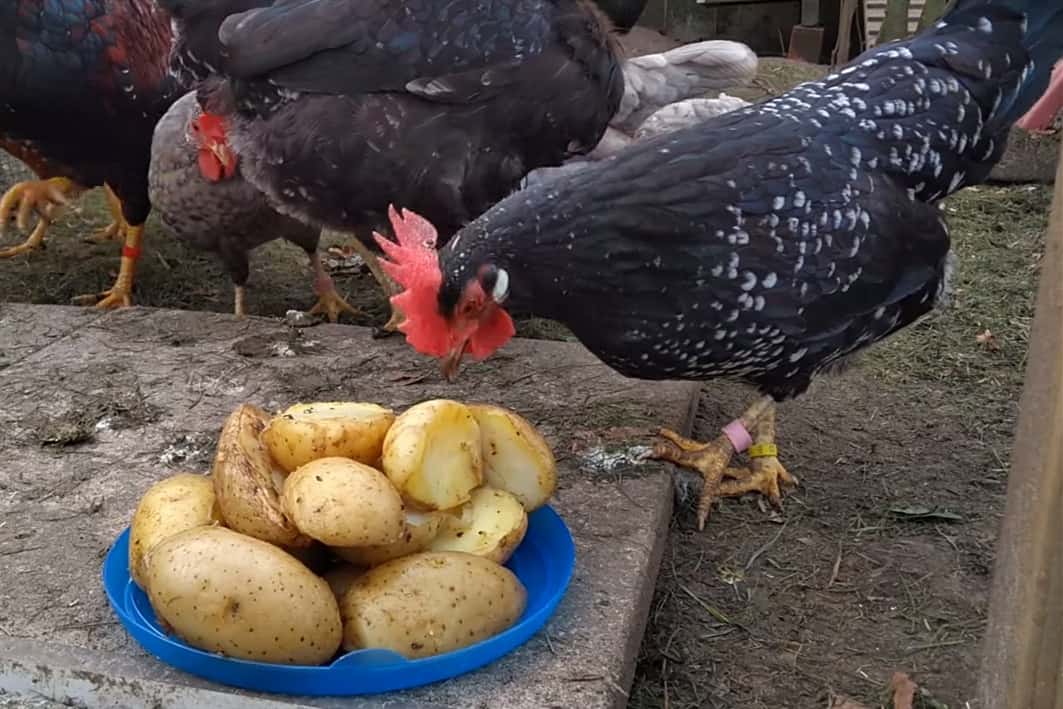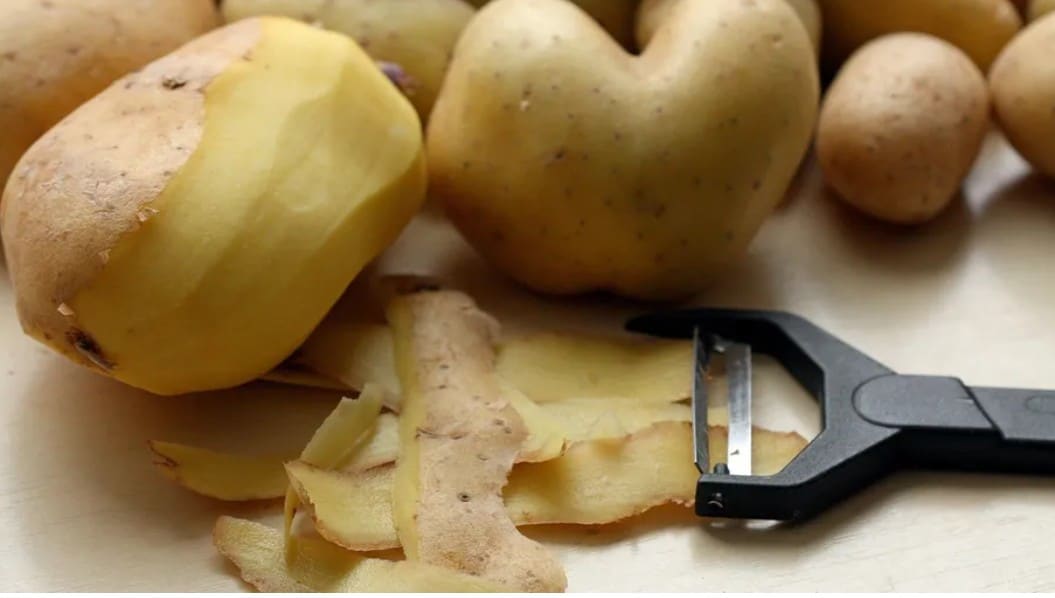Feeding chicken on table scraps effectively supplements chicken feed while minimizing waste. Since potatoes are an essential part of our diet, potato skins have become a staple of the kitchen trash cans. It’s no wonder we often get the question, “Can chickens eat potato peels?”
Let’s explore.

Yes, chickens can consume potato peels. However, it would be best to exercise caution as potato peel carries some risk. Look out for potato peels with green patches containing the toxic solanine. White or yellow potato skins that haven’t turned green are perfectly fine for chickens.
To tackle the safety of potato peels for chickens, we shall look at the health benefits and risks of potato skins to chickens. We shall also explore healthy alternatives to potato peels.
Do Potato Peels Have Any Nutritional Benefits?

Potato peelings contain various nutrients, including carbohydrates, protein, minerals, and fiber. Below is a breakdown of how these nutrients benefit the avian body:
Carbohydrates
Potato flesh is a rich source of carbohydrates. We slice some of the flesh while peeling potatoes, thus adding some starch to the peelings. Carbohydrates are a vital energy source for poultry.
Their bodies break down the starch into simple sugars like glucose which are absorbed and burned to generate energy. Excess glucose is stored as fat under the skin. The fat insulates the body from cold.
Protein
Though found in trace amounts (about 3 grams), potato peelings contain protein. After ingestion, the avian body breaks down the protein into amino acids. These amino acids are then used as building blocks to repair and grow muscles and organs.
Minerals
Potato skin is rich in minerals like iron, magnesium, and potassium. Iron is vital to manufacturing hemoglobin, which is responsible for carrying oxygen in the blood.
Potassium conducts the electrical charges responsible for muscle contraction. Through this process, the bird can maintain a regular heartbeat.
Magnesium is vital to the regulation of blood pressure. It also plays a role in nerve transmission.
Vitamins
Potato peels are rich in vitamins. These vitamins include vitamin B-1, vitamin B-3, vitamin B-6, and vitamin C.
Vitamin B-1, or thiamin, is a water-soluble vitamin essential to glucose metabolism. It also facilitates the normal function of the nerve, heart, and muscles.
Vitamin B-3, or niacin, plays a crucial role in energy production and the synthesis of certain hormones in the avian body.
Vitamin B-6 is vital to both metabolism and the function of the central nervous system. It facilitates the conversion of food into energy and the production of neurotransmitters (dopamine and serotonin). Dopamine and serotonin regulate the mood of chickens.
Vitamin C is an antioxidant. Apart from inhibiting inflammation, this vitamin prevents cellular damage.
Fiber
Potato peels are rich in fiber. Chickens need fiber in their diet to keep a healthy digestive system. The avian body can convert soluble fiber into energy. The insoluble fiber reduces the digestibility of fat, starch, and proteins. In this way, fiber combats constipation.
Can Chickens Eat Potato Skins?

There are tons of discussions on online platforms about which kitchen scraps are safe for chickens and which are not. Potato peels are one of the most divisive of all table scraps.
The difference in opinion could be because potatoes come from the nightshade family of veggies. Vegetables from this class usually contain harmful toxins.
So, are potato peels toxic to chickens?
Not always. The color of the potato peels can indicate whether it is safe for consumption. The green hue on the skin means that it may contain solanine. This toxin usually concentrates on the potato plant’s eyes, skin, and leaves. Since solanine occurs along chlorophyll, the toxin manifests as a greenish discoloration of the peelings.
Solanine Poisoning in Chicken
Solanine is a glycol-alkaloid that is found in potatoes and other members of the nightshade family. This class of vegetables includes food that’s toxic to chicken. Members of this class are:
- Tomatoes
- Peppers
- Eggplants
- Capsicum (paprika and chili)
- Belladonna
- Tobacco
Solanine exists along with chlorophyll. It persists on any green part of the plant, including the leaves and stems. The toxin is formed in the parenchyma cells and concentrates under the potato’s skin.
Solanine forms when the potato is exposed to light. It’s the plant’s natural defense against pests and deters bug attacks.
Solanine is a neurotoxin that can cause many problems in chickens’ nervous and gastric systems.
Symptoms of solanine poisoning in chicken include:
- Vomiting
- Stomach pains
- Diarrhea
- Paralysis
- Fever
- Death
Reducing the Risk of Solanine Poisoning
So far, you can appreciate that potato peelings have health benefits. However, there is a substantial risk of solanine poisoning. Below are effective ways of safely feeding your chicken potato peels:
Pick the Right Potatoes
It all starts with your trip to the grocery store. The presence of solanine manifests as greenish patches on the surface of the skin. You want to avoid potatoes with a greenish shade. Opt for white, yellow, or red potatoes.
Ensure that the potato is still fresh and in good condition. Fresh potatoes are firm and free of mold or wrinkles. Inspect the eyes and ensure no shoots are growing off them.
As you return home, find the right place to store your potatoes. You want to store them dry away from the sun’s glare. Remember that potatoes grow in the dark below the earth’s surface. By exposing the tuber to sunlight, it turns on its defenses and concentrates patches of solanine on its skin.
When you’re ready to peel the potatoes, inspect them once more. Avoid potatoes with green patches. While they may be safe for human consumption (since we cook them), they could be fatal to poultry.
Pro Tip: Serve the chickens while the peelings are still fresh

Bake the Potato Peels
Baking potato peels can significantly reduce the toxicity of solanine. As always, only pick fresh potatoes free of green patches. Once selected, thoroughly wash your potatoes. Scrape and scrub off the dirt with a mild sponge and a jet of clean water. This cleaning process is necessary because we do not want our chickens to ingest sand and mud.
Once the potatoes are spotless, peel them with steady hands while minding your fingers. Wash the peelings once more and let them dry. You can speed up the process with paper towels.
Set your oven to 350 ° F. Glycol-alkaloids like solanine degenerate at 338 °F. On a baking sheet, lay out the potato peels. You can supplement the peeling with other veggies like kale or spinach. Do not add seasoning, as the ingredients may cause gastric irritation.
Once the oven is ready, cook the peelings for 30 minutes. Set a timer to remind you. We do not want to burn the peelings.
Once cooked, let the potato peels cool before serving. To optimize palatability, shred the peeling into smaller pieces; your chickens will thank you.
Test your chickens with small potions and see if they like them. If they do, Bon Appetit!
Avoid Serving Potato Peels
Another way of minimizing solanine poisoning is avoiding potato peels entirely. At least, this is the strategy in the commercial scene. You do not see intensive farmers sourcing feed supplements in McDanold’s trash cans.
Solanine poisoning comes with the risk of death. If you’re unsure, it’s best to avoid potato peels entirely. Other table scraps are healthy for poultry and do not come with the risk of death.
Right Serving of Potato Skin

When feeding chickens potato skins, moderation is key. Wash and pre-cook them in bite-sized pieces before offering them to the flock only once or twice a week.
It’s really important to balance carbohydrates like cooked potato skin with plenty of fresh vegetables, fruit, and other sources. The amount given per week should not exceed 10% of a chicken’s total caloric intake for the week.
The amount you’ll feed your chickens per week depends on the level of other treats they eat, such as dried mealworms or table scraps. Generally speaking, an ⅛ cup (2 teaspoons) of cooked potato skins twice a week will do the trick.
But that varies between individual birds so make sure when following our suggestion that you keep watchful for signs of your flock. Monitor your birds carefully after providing them as some can be sensitive and have reactions to different types of foods.
If this is the case, adjust their diet accordingly. Finally, when in doubt feel free to consult an avian vet about their specific needs.
Safe Alternatives to Potato Peels
Feeding your poultry table scraps is the right thing to do. After all, it is a creative way to reduce feeding costs while minimizing kitchen waste. While produce from the nightshade family of vegetables comes with risk, there are table scraps that are safe for chickens.
Below are some healthy substitutes for potato peels:
Sweet Potato
Sweet potato is rich in dietary fiber, with four times as much as regular potatoes. Fiber helps to maintain a healthy digestive system for chickens. Sweet potato also has countless health-benefiting phytonutrients such as beta-carotene (a form of vitamin A), which ensure healthy vision and enhance the quality of plumage in chickens.
In addition, sweet potatoes are considerably low in saturated fats compared to white potatoes so consuming them rather than white skins increases overall nutritional benefit without adding fat content into the diets of chicken poultry.

Cooked Meat
Meat is an excellent source of protein. Chickens need amino acids (protein building blocks) to repair tissue and develop organs. However, large pieces of meat are a choking hazard to chickens. Before feeding your chickens, ensure that you shred the cooked meat into tiny pieces.
Bread Crumbs
Bread is rich in carbohydrates. And like other birds, chickens are fond of bread. Any bread will do, as chickens are not choosy. However, it’s recommended that you serve them small quantities of high-value bread.
Note that you should avoid moldy or stale bread.
Grains
Humans have been feeding chickens grains, probably since we domesticated the bird. Chickens are fond of grains like rice, corn, wheat, and oatmeal. These grains are rich in fiber and carbohydrates. As carbs provide energy, fiber aids in metabolism and combats constipation.
Although grains are perfectly healthy, overconsumption can lead to obesity. Feed in moderation.
Verdict: Can Chickens Eat Potato Peels?
Yes, chickens can eat potato peels as long as the potato peels are fresh and haven’t turned green. The green hue is an indication of the presence of the toxin solanine. This neurotoxin persists alongside chlorophyll and manifests as a green patch on the potato skin.
Solanine can cause gastric irritation, paralysis, and even death in chickens. You can minimize the risk of solanine poisoning in any of the following ways:
- Avoiding potatoes with green patches
- Serving fresh peelings that haven’t turned green
- Baking potato peels
- Avoiding potato peels entirely
Like other table scraps, potato peels can supplement chicken feed. However, it would be best if you served it in moderation.

Joseph Hudson has been raising chickens for over 15 years. In 2018, he completed the Agriculture & Natural Resources program at Mt. San Antonio College. He currently raises over 1400 chickens on his 7.5-hectare farm. He keeps sharing his experience on raising healthy and happy chickens on Chicken Scratch The Foundry.






